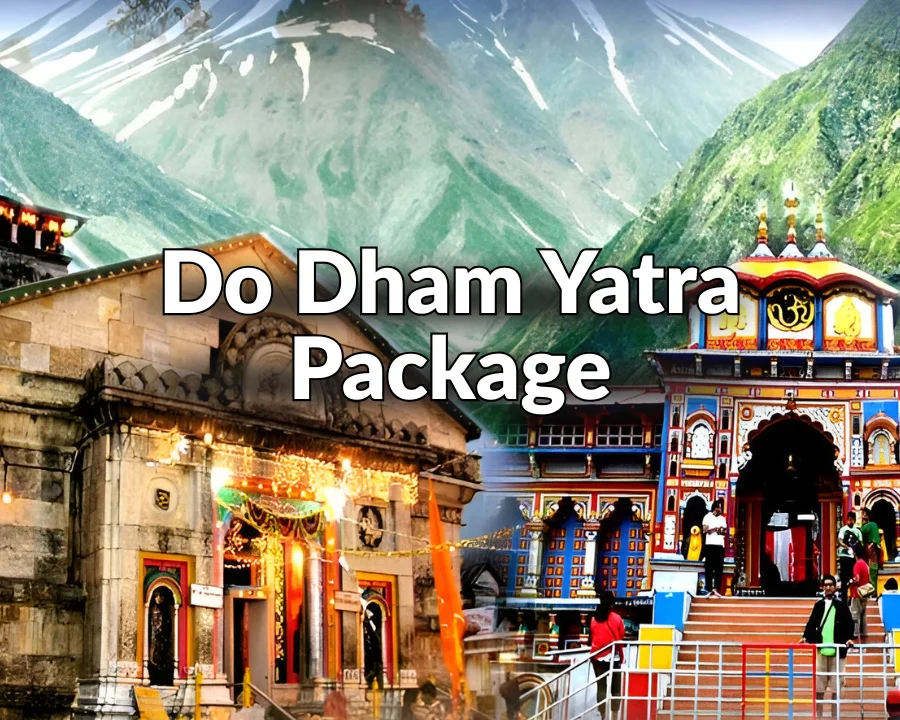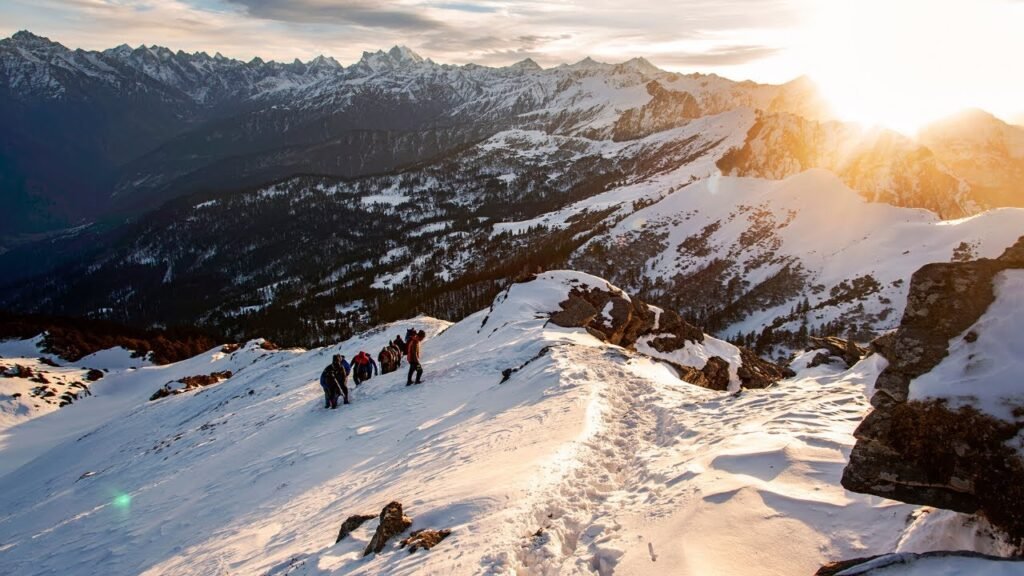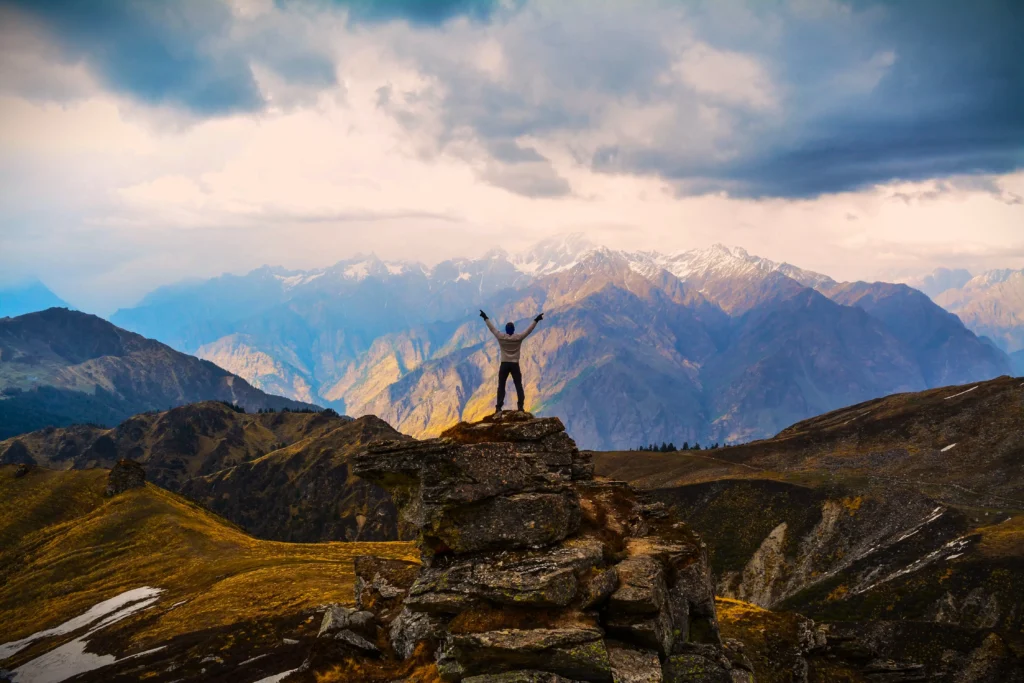
The mountains are calling you, their voice both ancient and mindful; a whisper on the wind that echoes of peace, adventure & spiritual awakening. For centuries, pilgrims have flocked to the Garhwal Himalayas, drawn not only by views that are truly breathtaking but also by the sense of spiritual significance with which they imbue these sites. This spiritual quest is known as the Char Dham Yatra, a sojourn to the four holiest shrines that are situated in the lofty Himalayas: Yamunotri, Gangotri, Kedarnath and Badrinath.
This yatra is not just a journey: It’s an epic in faith, resilience and transformation. Every stride along these sanctified trails takes you closer to nature’s splendor and your inner core. This guide will teach you everything you need to know in order to experience this life changing journey.
What is the Char Dham Yatra?
As the Char Dham become popular, the numbers of people visiting annually have also increased. The pilgrimage is traditionally done in the clockwise direction starting from Yamunotri, then proceeding to Gangotri, Kedarnath and finally Badrinath. It is thought this circuituredis exchanged of sins allows clear passage along the path to “moksha”, or spiritual liberation.
History and Religious Significance
This tradition of pilgrimage is associated with a great famous philosopher and reformer of the 8th century known as Adi Shankaracharya. According to traditional stories, he made pilgrimage to these sites with the intention of revitalizing the Hindu faith which had been overrun by Buddhism. He made a pilgrimage to the Badrinath temple and turned it into a prominent center of Hindu religion by installing the image of Lord Vishnu there; he also recognised the other three as tripadkshetras.
Each of the four dhams has an unique place in the Hindu mythology.! Yamunotri is the source of Yamuna river, Gangotri the origin of Ganga, Kedarnath one of the twelve ‘jyotirlingas’ of Lord Shiva and Badrinath — shrine to Lord Vishnu. Combine, and you have a mighty spiritual circuit.
What Makes This Journey So Special?
This travel is amalgamation of spirituality, culture & adventure.
Spiritual detoxification: Followers believe washing in those water cleanses them of the sins both of the current life and their previous lives. It’s thought of as a form of penance that cleanses your soul.
Himalayan Majesty: The route is among the most beautiful landscapes on earth. You’ll see mighty peaks covered in snow, beautiful lush green valleys, roaring rivers and peaceful alpine meadows. You’ll be humbled and awed by the raw, untamed beauty of Garhwal Himalayas.
A Rich Cultural Tapestry: An age old temples, boisterous village folks, and co-pilgrims that come in all walks of life. The air is heavy with chants, prayers and stories that date back hundreds of years.
An Overview of the Four Dhams
Every place throughout the Char Dham Yatra has its unique feature, myth and divine force.
Yamunotri: Birth Place Of The Yamuna Goddess (!st Day)
Location & Altitude: Located in the Uttarkashi district at an elevation of 3,293 metres (10,804 feet), Yamunotri is dedicated to Goddess Yamuna. The shine is a humble place with a deep spiritual core.
The journey: The driveable road is till Janki Chatti. From there, a 6-kilometer hike leads to the temple. Itc is a concrete path and can be traversed on foot, by pony or by doli (palanquin). The trek is a pretty one with the gushing Yamuna river accompanying you all along.
Best Time to visit Sumitranandan Pant Museum Besides the museum; visitors can also explore a lot of other attractions in Kausani including Anasakti Ashram, Rudradhari Falls & Caves and Kausani Tea Estate. Highlights: Surya Kund is another important place close to it which uses thermal water spring where thousands of pilgrims plunge into this ultimate adventure destination Apart from the fact that many visitors do not know, but they cook rice and potatoes by dipping them in these springs after tying them inside outfit pieces Visit for History refineries like Sharda Paper And Luminous Valley As an established hill station with all modern facilities, there are also small cottage industries that bring a local touch good to buy things at reasonable rates The fighting scenes have been depicted through various scenes available over here Best T… The Divya Shila, a sacred rock pillar is to be worshipped before puja in temple.
Optimal Time to Visit: May-June and September-October sidenote: watch the temperatures!

Gangotri: The Abode of Goddess Ganga
Location & Altitude: Gangotri stands at an altitude of 3,100m and the river Ganga or Ganges starts its 2525 Kms, long journey to meet the Bay of Bengal from here in the Indian plains. Gangotri Temple, a white marble temple on the banks of Bhagirathi.
The Journey: It is easy to approach Gangotri by road and hence it is comparatively less strenuous dhamattain. But the spiritual quest doesn’t stop there for a lot of people.
White Highlights: Bhagirathi Shila is a pious rock and it’s said that the King Bhagirath meditated here. For the adventurous, a tough 18km trek from Gangotri leads to Gaumukh, the source of the true Ganga at its glacier. This is part of the famous Gaumukh Tapovan trek.
Best Time to Go: The temple is open from late April/early May to slightly past Diwali.
Loading… Kedarnath: The Home of Shiva
Location & Altitude: The Kedarnath temple, is located at an extremely high elevation of 3,583 meters (11,755 feet), against the stunning backdrop of the glorious Kedarnath peak and it is among one of the most famous temples dedicated to Lord Shiva. It is the twelfth Jyotirlinga in India.
The Journey: Kedarnath is not a place that can be easily reached. Gaurikund is the place where motorable road ends. From there, it is a 16-kilometer hike up hill to the temple. The route is well-kept, but tough because of the elevation. Helicopter services are also available.
Key Highlights: The massive stone structure that was constructed by the Pandavas, long back ago and restored by Adi Shankaracharya has a fearful and divine look. Its setting, amid the brooding snow and crag of the lower peaks and valley of the Mandakini River only heightens that sense of mystique.
Optimal Time to Visit: Weather-wise, May to June and September through mid-October are the best months for the trek.
Badrinath: The Abode of Lord Vishnu
Location & Altitude: Perched at an elevation of 3,300 meters (10,827 feet) amidst the Nar and Narayan mountain ranges, Badrinath is dedicated to Lord Vishnu. It is a brightly painted temple against the awesome backdrop of the Neelkanth peak.
The journey Direct road connectivity Badrinath is one dham out of the four that has direct road connection.
Significance: The holy thermal spring is believed to have great medicinal value. The temple’s colourful architecture and the quiet location near the shores of Alaknanda River ensures a great atmosphere of tranquillity. Last Indian village before the Tibet border at a distance of few kilo meters is Mana, it’s an interested place to go and see.
Visiting: The temple is open for six months, usually between late April through early November.
Char Dham Yatra – An Ideal Itinerary for Your Journey
The good old itinerary is what makes or breaks your trip. Find out recommended 10 day trip itinerary while travelling to Haridwar/Rishikesh.
Day 1: Arrive in Haridwar/Rishikesh. Get ready for the long walk ahead.
Day 2: Haridwar to Barkot (for Yamunotri ). A long drive in the mountains.
Day 3: Barkot to Yamunotri and back to Barkot (50 Km drive + 6 KM trek) Drive to Janki Chatti, trek Yamunotri and back.
Day 4: Barkot to Uttarkashi. A picturesque journey to the next dham.
Day 5: Uttarkashi-Gangotri-Uttarkashi Visit the Gangotri temple.
Day 6: Uttarkashi to Guptkashi/Sersi (for Kedarnath). Long and difficult travel day to the Kedar valley.
Day 7: Guptkashi/Sersi to Kedarnath. Drive to Gaurikund and then trek/ fly to Kedarnath. Overnight stay at Kedarnath.
Day 8: Kedarnath to Guptkashi/Sersi. Hike/fly back down or fly both up and down after morning prayers.
Day 9: Guptkashi to Badrinath. Drive to the last of the dhams, Badrinath.
Day 10: Badrinath to Rishikesh/Haridwar. After lunch and temple visit, drive back downward to the plains.
There is time enough for everyone to rest and not rush, because you need it on this route for sure.
Best Time of the Year for the Char Dham Yatra
It is the timing of your yatra that carries the most weight in getting ready. The Himalayas are an inhospitable one.
Pre-Monsoon (May to June): It is the time when you should go. The weather is nice, skies are usually clear and trails are snow-free. It is also the busiest time.
Post-Monsoon (September to October): Another great window. The monsoon rains have scoured the land, making it verdant and alive. The crowds are thinning, and the weather is cool and clear.
Avoid (July-August & Winter): Heavy rain in monsoon months, increasing the chances of landslides and road blockages. The temple becomes closed in winter (November to April) due to heavy snow fall.

Difficulty Level and Physical Preparation
The Char Dham Yatra is not a breezy affair. It includes a lot of road travel on winding mountain road, Serious gain in altitude and trek with difficulty.
Altitude: You are visiting locations at an altitude of over 3500 meters. Acclimatisation is the single best way to prevent AMS. Walk slowly, drink enough water and let your body acclimatize.
Trekking: The trails up to Yamunotri and in particular Kedarnath have to be hiked and good physical condition is required. Start training up to a month before your trip. Add cardiovascular exercise, such as jogging, cycling or fast walking.
Moderation: Always trust your guide, but also listen to your body. You don’t have to push yourself so much. The mountains demand respect.
Yatra Essential Packing List
Packing intelligently is crucial for traveling to your destination hassle-free.
Clothing: Layering is key. Carry thermal inners, fleece jackets, one waterproof with wind stopper outer jacket and the other a pair of comfortable trekking pants.
Shoes: You can survive without the latter if necessary but dont skimp on hiking shoes that are tough, waterproof with good grip.
Essentials: Daypack, water bottle, sunscreen and sun glasses, lip balm and a basic first-aid kit with headache pills, anti-nausia pills and anti-altitude sickness medicine.
Religious Items: There is no need to pack much more than a few small puja items or offerings; they are easily found in India.
Documents: Be sure to have your ID, permits and booking confirmations within reach.
Weather Conditions to Expect
Himalayan weather can be unpredictable and change quickly.
Daytime Temperature: In yatra season, daytime temperatures will be approximately 10 to 20°C.
Temperature in the night: Nights are chilly with temperatures going down to 0°C and even less in higher reaches such as Kedarnath.
Rain: Monsoons aside, expect some periodic rain showers. Higher altitudes may see snowfalls in early May and late October.
Permits, Safety and Hiring a Guide
Although the yatra can be done by individual pilgrims, it is better to do it with a professional tour operator like The Mountain Trekker due to safety and experience factors.
Permits: Pilgrims must be registered. This is something that tour operators take care of for you.
Safety: The mountains are unpredictable. A guide should know that the terrain, the local weather patterns and how to respond in an emergency. They help keep you on safe trails and acclimate properly.
The logistics: Because package tours take care of your transportation, lodging and sometimes meals, you can be fully focused on your spiritual journey.
Why Choose The Mountain Trekker?
At The Mountain Trekker, we do not just plan tours; we create spiritual journeys. It is our deep love for the Himalayas and our dedication to our guests that sets us apart.
Guides: Our plane is flown by locals who grew up in these mountains. They trade stories, knowledge and a common respect for the culture and environment.
Your safety begins here. We also carry first-aid kits, as well as O2 cylinders for use in emergencies – our guides are trained in wilderness first aid.
Seamless Itineraries: We handle the details, so you don’t have to worry about a thing—except for enjoying great rides, clean & comfortable accommodations and permits. Our Char Dham Yatra package is designed with an easy travel trip!
Small Groups: We are into the personal touch. Small group sizes allow for individualized attention and deeper connection to your travelling peers and the journey itself.
Ready to Embark on Your Sacred Journey?
The Char Dham Yatra is an appealing call to break the shackles and place yourself on a journey where self-revelation is ascertained in harmony with divine. It’s an experience that will push you, motivate you and never be forgotten.
Join us on this hallowed journey.
Call us now to book your Char Dham yatra package and make memories that stay with you till the eternity.
📞 Call Us: +91 9650644062, +91 7060358231
📧 Email Us: info@themountaintrekker.com
➡ [Plan and Book Your Char Dham Yatra Package Today]

Frequently Asked Questions (FAQs)
Which is the best time to go on Chardham Yatra?
The best time to go is pre-monsoon (May-June) or post-monsoon (September-October); the weather would be good and routes would be open and safer to transverse.
Let’s see if the Char Dham Yatra is possible for first-timer or senior citizens?
Yes, but with proper planning. Although the trek to Kedarnath is arduous, alternatives such as ponies, palanquins (doli) and helicopter services are available. Gangotri and Badrinath are connected with the road. Best to consult a physician and opt for a well-regulated package.
How do I get to the initial points such as Haridwar or Rishikesh?
Haridwar and Rishikesh are well-connected. The closest airport is Jolly Grant Airport (DED) in Dehradun. Haridwar is well connected by rail and the two towns are accessible by good roads from Delhi or other parts of India.
How much does a Char Dham Yatra package cost?
The price varies according to the length, level of comfort (hotel, type of vehicle) and inclusions. A basic pack can be budget and luxurious. Please call us for a custom quote for your organization.
Can children come for the yatra?
Yes, children can accompany adults. Though the high altitude and strenuousness of some of the trek, we recommend children be a minimum of 10-12 years old and active. Always check with a pediatrician first before making the journey.
If you loved reading about this you might also like Kedarnath Yatra




